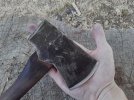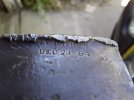JM2
Basic Member
- Joined
- Mar 11, 2013
- Messages
- 2,162
I see lots of pictures of axes with this beautiful dark brown patina, and a shiny edge. How do you get that patina? All the axes I see hither and yon are either, fiercely rusted, or painted.
I currently ain’t got an axe other than an estwing camping axe and a fiskers splitting axe. But I been wanting a double bit for my cabin project and for the fun of it.
So if I buy an axe head (not super pitted just light rust) off eBay or a yardsale, how best to bring it back? Oil and scotchbright pad is how I would think to start. But I want ideas and opinions.
Thanks.
I currently ain’t got an axe other than an estwing camping axe and a fiskers splitting axe. But I been wanting a double bit for my cabin project and for the fun of it.
So if I buy an axe head (not super pitted just light rust) off eBay or a yardsale, how best to bring it back? Oil and scotchbright pad is how I would think to start. But I want ideas and opinions.
Thanks.




